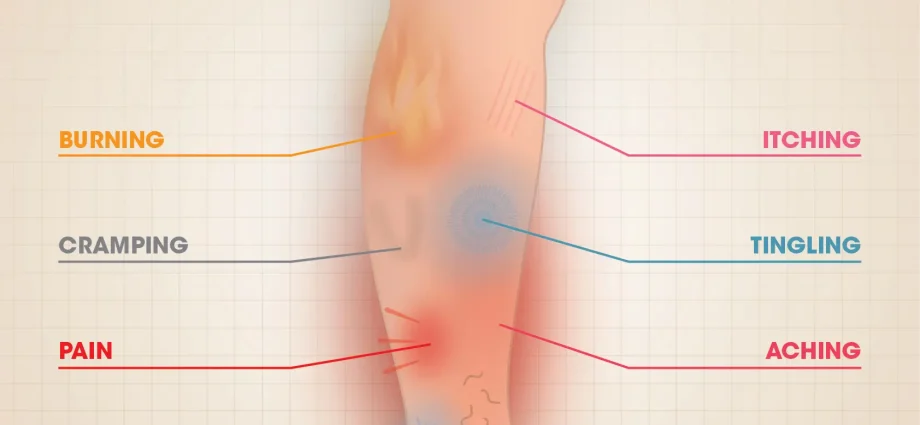Contents
What is Restless Leg Syndrome in Adults?
Restless legs syndrome (RLS) is a rather severe disorder of the nervous system, characterized by unpleasant sensations and discomfort in the legs. Usually, symptoms appear or worsen when resting, lying in bed before going to bed. If you walk, stretch or move your legs, it gets much better, but after a few minutes, the legs again make themselves felt. In this state, it is very difficult to fall asleep, it is impossible to relax and rest, the night can become a real torment, and as a result, insomnia and chronic lack of sleep occur.
For the first time, restless legs syndrome was discovered in 1672 by the English physician Thomas Willis, therefore, the name of the pathology is sometimes found as “Willis’s disease.” Most often, restless leg syndrome occurs in women (especially pregnant women) and the elderly. In healthy, strong men, RLS is much less common, and almost never in children and adolescents.
Causes of Restless Leg Syndrome in Adults
As many experts note, the root cause of restless leg syndrome is still unknown, and often the disease appears abruptly and spontaneously. RLS often occurs in people with psycho-emotional disorders, prone to stress, overly impressionable. Sometimes there may not be any such factors. Also, RLS often appears in those who abuse caffeine and alcohol, as well as in those who have suffered spinal cord injuries.
Restless legs syndrome is a very common disorder of the nervous system. Distinguish between primary and secondary RLS. Primary restless legs syndrome is an independent disease, secondary occurs against the background of other diseases, for example, damage to the peripheral nerves or kidneys, diabetes mellitus. It has been established that iron deficiency and impaired dopamine metabolism play a role in the development of RLS. Certain medications (eg, antipsychotics, certain antidepressants, lithium) can also cause restless leg syndrome in adults, explains neurologist Elena Gayvoronskaya.
Symptoms of Restless Leg Syndrome in Adults
Often, patients cannot even describe the symptoms and sensations they experience with restless leg syndrome. Of course, a person does not experience any pain, but he complains of discomfort, an irresistible desire to move his legs, scratch them. Someone notes a certain itching, goosebumps, needles, “running” along the legs, which intensify in a stationary state.
To get rid of unpleasant sensations, a person is forced to constantly move his legs – hence the name “restless legs syndrome”, and as a result – sleep disturbance, headaches, insomnia, irritability, fatigue, apathy, disorders of the digestive system, and sometimes even depression.
Treatment of Restless Leg Syndrome in Adults
Restless legs syndrome itself is not dangerous, but it can cause serious discomfort in a person. Therefore, stop tolerating insomnia and other unpleasant symptoms and consult a neurologist who will quickly identify the problem and select the appropriate treatment.
Diagnostics
– The diagnosis is established on the basis of a conversation with the patient (in medical language, this is called the collection of complaints and anamnesis). The doctor assesses whether the patient’s descriptions meet the established criteria: discomfort in the legs during rest (mainly at night before going to bed), discomfort causes the patient to move, after which there is temporary relief. Patients may describe their sensations in the legs as “moving under the skin”, “passing current”, “bursting bubbles”, “worm crawling”, “tickling”, “tension”. Sometimes it is difficult for patients to find words to express their complaints. Of the additional methods, a blood test is needed to assess iron deficiency, and the doctor may also prescribe an examination to exclude secondary RLS, – explains neurologist Elena Gayvoronskaya.
Modern treatments
If, nevertheless, unpleasant symptoms overtook you, then to alleviate them, you need to walk around, ride a bike, take a cold or, on the contrary, a hot shower. Good massage of the feet helps them rubbing and tingling. Yoga and acupuncture are alternative therapies with low-quality evidence, but are nevertheless mentioned in the guidelines.
– With an established iron deficiency, it is necessary to replenish it, it must be remembered that with RLS the target level of ferritin is 50 – 75 μg / l. In more severe cases, drugs are used that affect the metabolism of dopamine (pramipexole, rotigotine, ropinirole), the doctor clarifies.
Prevention of Restless Leg Syndrome in Adults at Home
To sleep peacefully and soundly at night, and not listen to the discomfort in your own legs, you should follow a few simple rules:
- adhere to a healthy lifestyle – walk as much as possible before going to bed in the fresh air, do physical exercises, after which you will sleep soundly;
- Take a warm shower before bed to help you relax and de-stress.
- take vitamins and iron supplements if you have anemia;
- if you have a sedentary job, get up more often, take a walk, change your position;
- give up cigarettes and alcohol;
- Avoid stressful situations, relax more often, meditate.
Popular questions and answers
We asked about Restless Leg Syndrome neurologist Elena Gayvoronskaya.










